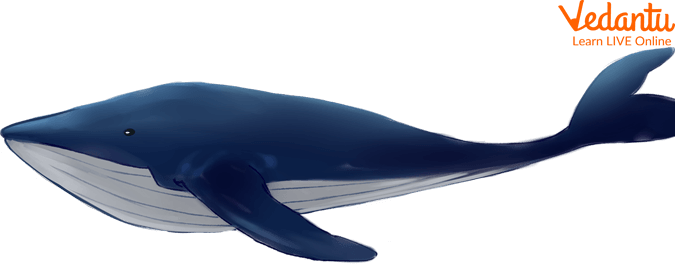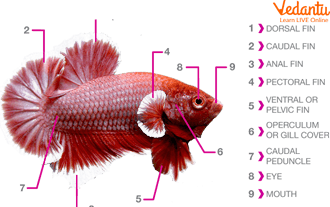




Introduction to Fish
There are many distinct kinds of fish that exist in the world, each with its own anatomy. Fish come in a variety of shapes, colors, and sizes, yet they all share some characteristics.

Fish
Fish are vertebrates, which means they have a backbone like humans. Fish are aquatic animals, which means they live in water. Fish are cold-blooded animals because they cannot regulate their body temperature based on their surroundings.
Fish Body Parts
The morphology of fish is another term for fish anatomy. Studying different sections of fish will help you learn the names of different fish body parts in English. It will also boost your curiosity about aquatic bodies and aquatic delights. We will learn about the interior and external body parts of the fish in this section.
Let's start with a closer look at a fish's body!

Fish Body Parts
General Body of a Fish
Mainly there a four general body areas of a fish these are:
Dorsal
Ventral
Anterior End
Posterior End
Dorsal refers to the back. The belly is found in the Ventral region. The fish's head is known as the anterior area, and the tail is located at the posterior end. A fish's body is divided into three main sections: the head, the trunk, and the tail. The brain, the eyes, the nostrils, and the mouth are all housed in the head. The trunk is the fish's primary body, and it contains the skeleton, spinal cord, and all of the internal organs.
Fish Parts Name
Anal Fin
Caudal fin
Dorsal fins
Eye
Eyes
Gill
Gill cover
Lateral line
Mouth
Nostril
Pectoral fin
Pelvic fin
Scales
Anal Fin:- The anal fin is present on the fish's ventral (bottom) portion, towards the tail. When swimming, this fin helps to maintain the fish and provides balance.
Caudal Fin:- Fins are located in various sections of a fish and serve various functions. The caudal fin, for example, is typically used to accelerate the movement. As a result, it is known as their tail fin.
Dorsal Fins:- Dorsal fins are present on the top of the fish. These fins help to support the fish and manage its movement into the water. They prevent the fish from turning on its side by expanding the lateral surface of the body.
Scales:- Scales are thin, protective plates covering the body of the fish. They aid in the lowering of drag in water (the force that opposes movement) and the protection of the fish from predators.
Eyes:- It gives the fish sight, which is mostly used for locating food, predators, and opponents. They are positioned laterally on the upper half of the fish's side. Fishes in the deep sea have large eyes, whereas fish in a highland stream have small eyes.
Gills:- The fish's gills are positioned on either side of its head. They are used to release carbon dioxide while taking oxygen from water.
Gill Cover:- They are known as the operculum and are normally present in bony fishes. They offer facial support and cover for the gills, which allows the fish to feed and breathe.
Lateral Line:- The lateral line is a network of pores that extends the fish's body. These pores detect vibrations in the water and detect water movement.
Mouth:- This is the fish's primary feeding organ. The form of a fish's mouth is determined by its size, the food it consumes, and the depth of water in which it floats.
Nostril:- Fish nostrils are positioned on the top of the head and allow the fish to smell the water. Their nostrils are not involved in the respiratory process. Fish can tell whether another fish is hurt and if they need to escape from predators by smelling the water.
Pectoral Fin:- They are found behind the gill cover in pairs on both sides of the fish. They serve various functions in different types of fish. For example, they generate a lifting force in a shark while assisting flying fishes to fly.
Pelvic Fin:- The pelvic fins are paired and placed at the fish's ventral (bottom). They assist the fish stop moving and providing stability.
Summary
Fish are vertebrates, which means they have a backbone like humans. Fish are aquatic animals, which means they live in water. Fish are cold-blooded animals because they cannot regulate their body temperature based on their surroundings. A fish's body is divided into three main sections: the head, the trunk, and the tail.
FAQs on Parts of a Fish Names: Learn About Fish Anatomy
1. What are the main external parts of a fish?
A fish has several main parts on the outside of its body. These include the head (with the mouth, eyes, and nostrils), the body, and the tail. You will also see fins, scales covering the body, and the gills, which are usually protected by a gill cover.
2. What is the function of fins on a fish?
Fins are like the steering wheel and propellers of a fish. They help the fish do several important things:
- Move forward: The tail fin (caudal fin) pushes the fish through the water.
- Steer and turn: Other fins on the side (pectoral fins) help it turn left or right.
- Stay stable: Fins on the back (dorsal fin) and belly (anal fin) stop the fish from rolling over.
3. How do gills help a fish breathe underwater?
Gills are special organs that allow fish to breathe. A fish takes water into its mouth and pushes it over the gills. The gills are full of tiny blood vessels that absorb dissolved oxygen directly from the water, just like our lungs take oxygen from the air. Carbon dioxide waste is then released back into the water.
4. What are scales and why do fish have them?
Scales are small, thin plates that grow out of a fish's skin and cover its body. They act like a suit of armour, providing protection from predators, parasites, and injuries. The scales are also often slimy, which helps the fish glide smoothly through the water.
5. What is the lateral line on a fish?
The lateral line is a special sense organ that looks like a faint line running along each side of the fish's body. It is made of tiny pores and nerve endings that can detect vibrations and pressure changes in the water. This helps the fish sense nearby objects, predators, and prey, even in dark or murky water.
6. How do a fish's body parts work together to help it survive in water?
All of a fish's parts are adapted for an aquatic life. Its streamlined body shape reduces water resistance, making swimming easier. The fins help it move, steer, and balance. The gills are perfectly designed to extract oxygen from water. Scales provide protection, and the lateral line acts as a navigation system. Together, these features make fish perfectly suited to their underwater environment.
7. Besides fins, how does a fish's shape help it swim?
A fish's body shape is crucial for efficient swimming. Most fish have a streamlined or torpedo-like shape, which is pointed at the front and tapered at the back. This shape allows water to flow smoothly over the body, reducing drag (water resistance). This means the fish can swim faster using less energy.
8. Do all fish have the same body parts?
While most fish share basic parts like a head, fins, and gills, there are many variations. For example, some fish like catfish don't have visible scales. Others, like eels, have a long, snake-like body instead of the typical fish shape. The shape and size of fins can also be very different depending on where the fish lives and how it moves.
9. What are the most important internal organs of a fish and their jobs?
Inside a fish, you'll find several important organs. The main ones are:
- Brain: Controls the body's functions and senses.
- Heart: Pumps blood throughout the body.
- Stomach and Intestines: Digest food and absorb nutrients.
- Swim Bladder: A gas-filled sac that helps the fish control its buoyancy, allowing it to float at different depths without sinking.









